Iceberg A-68
Iceberg A-68 was a giant tabular iceberg adrift in the South Atlantic, having calved from Antarctica's Larsen C ice shelf in July 2017.[1][2][3] By 16 April 2021, no significant fragments remained.[4]
_MOD_45167693.jpg.webp)
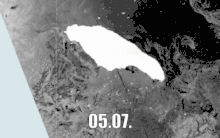

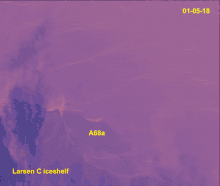
With a surface area of 5,800 square kilometres (2,200 sq mi), twice the size of Luxembourg, over a quarter the size of Wales, and larger than Delaware,[5] it was one of the largest recorded icebergs, the largest being B-15 which measured 11,000 square kilometres (4,200 sq mi) before breaking up. The calving of A-68 reduced the overall size of the Larsen C shelf by 12 percent.[5][6]
Historical data shows that many icebergs that break off from the Antarctic Peninsula reach South Georgia and the South Sandwich Islands.[7]
The name "A-68" was assigned by the US National Ice Center. It broke into parts with the mother berg dubbed A-68A. The larger child icebergs were designated in order of birthing, as A-68B, A-68C, A-68D, A-68E, A-68F, and in January 2021, splitting almost in half to birth A-68G. On 30 January 2021, Iceberg A-68A broke into other icebergs called A-68H, A-68I, A-68J, A-68K, A-68L, A-68M.
History and recent developments
A-68 was part of Larsen C, a section of the Larsen Ice Shelf. Scientists found the crack beginning to form in November 2016. Scientists assess that A-68 "didn't just break through in one clean shot, [but] it formed a lace-network of cracks first."[5] The resulting iceberg was around 175 km long and 50 km wide, 5,800 km² in area, 200 m thick and weighed an estimated one trillion tonnes.[8][5]
Satellite images from the ESA and EU's Copernicus Program show that as the iceberg moved, it was gradually shrinking and splintering, forming more icebergs in the process.[9]
Scientists are looking into the possibility of the ice shelf collapsing as a result of the split with A-68, or whether the iceberg was the "cork" for Larsen C that allows ice to flow more freely into the sea, thereby contributing to rising sea levels.[10]
Post November 2017, satellite images showed that A-68 was slowly drifting northward, with a widening gap to the main shelf. The gap was approximately five kilometers (3.1 miles) wide and contained a thin layer of loose, floating ice and a cluster of more than 11 'smaller' bergs, one much larger than the others.
A British expedition on RRS James Clark Ross intended to sample the marine life at the A-68 cleavage line in March 2018, but had to turn back due to thick sea ice.[11] During 2018, A-68 continued to drift northwards.[12] In 2018 or 2019, a large chunk almost 14 km × 8 km (9 miles × 5 miles) broke off and was named A-68B, with the mother iceberg now being A-68A.[13]
On 6 February 2020, A-68A began moving into open waters.[14] On 23 April 2020, a chunk measuring about 175 sq. km. (70 sq. mi.) broke off the iceberg and was named A-68C.[15]
On 4 November 2020, it was reported that A-68A was approaching South Georgia Island and that there was a strong possibility that the iceberg might run aground on the shallower continental shelf near the island, posing a grave threat to local penguins and seals. A spokesman from the British Antarctic Survey stated that the iceberg could become stuck for a number of years, causing disruption to wildlife and the local fishing industry.[16]
On 9 December 2020, the Royal Air Force released video footage of A-68A, 150 km off South Georgia. The RAF conducted reconnaissance flights over the iceberg on 18 November and 5 December 2020.[17]
As of 17 December 2020, a part of the iceberg was just 50 km (31 mi) from South Georgia, but the concern seemed to have lessened. National Geographic reported that "[s]cientists expect the iceberg ... to either anchor in the shallow waters around the island or move past it in the coming days."[18] On this date it was also reported that a corner had been knocked off A-68A, most likely due to impact with the seabed.[19] The new free floating iceberg has been designated A-68D.[20]
On 22 December 2020, images from ESA's Sentinel-1 radar satellite showed that A-68A had experienced a major break-up. Two of the larger fragments were named A-68E and A-68F.[21] A modeling study demonstrated that this break-up was likely triggered when part of A-68A became positioned within stronger ocean currents than the rest of the berg, generating enough tension along its body to break it into pieces.[22]
On 28 January 2021, Sentinel-1 discovered that the southern third of A-68A had broken away. The new segment was named A-68G, with an area of around 950 square kilometres (370 sq mi). The imagery shows these two bergs around 135 km south-east of South Georgia drifting close together.[23][24]
On 30 January 2021, Iceberg A-68A broke up into other icebergs called A-68H, A-68I, A-68J, A-68K, A-68L, and A-68M.[25][26]
On 15 February 2021, it was reported that British scientists had arrived at the remnants of A-68A, and had deployed a robotic glider to measure seawater salinity, temperature and chlorophyll close to the remaining blocks of ice to ascertain effects on local marine life.[27]
On 16 April 2021, the largest fragment was down to 3 nautical miles in length and the U.S. National Ice Center, which names, tracks, and documents Antarctic icebergs, discontinued tracking,[4] as the Center only studies icebergs that are at least 20 sq. nautical miles, or that measure 10 nautical miles on the longest axis.[28]
Gallery
 Radar imagery from Sentinel-1B taken on 12 July 2017, showing the complete break
Radar imagery from Sentinel-1B taken on 12 July 2017, showing the complete break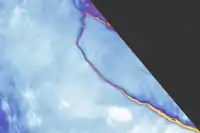 A-68 on 12 July 2017
A-68 on 12 July 2017 Close-up of A-68 on 20 July 2017
Close-up of A-68 on 20 July 2017 Close-up of A-68 on 9 December 2019
Close-up of A-68 on 9 December 2019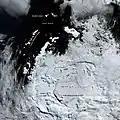 A-68A location on 9 February 2020
A-68A location on 9 February 2020
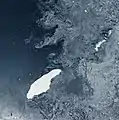 A-68A in open waters on 5 July 2020
A-68A in open waters on 5 July 2020
References
- "Larsen C calves trillion ton iceberg". Project MIDAS. 12 July 2017. Archived from the original on 12 July 2017. Retrieved 12 July 2017.
- "Giant iceberg splits from Antarctic". BBC. 12 July 2017.
- "Massive iceberg breaks away from Antarctica". CNN. 12 July 2017. Retrieved 13 July 2017.
- Amos, Jonathan (18 April 2021). "A68: Iceberg that became a social media star melts away". BBC News. Retrieved 18 April 2021.
- Davis, Nicola (2 August 2017). "What happened next to the giant Larsen C iceberg?". The Guardian. ISSN 0261-3077. Retrieved 2 August 2017.
- McKie, Robin (31 January 2021). "Extraordinary voyage: on the trail of the trillion-tonne runaway iceberg". The Observer. ISSN 0029-7712. Retrieved 31 January 2021.
- Mosher, Dave (12 July 2017). "Where Antarctic iceberg from Larsen C shelf might go in Southern Ocean". Business Insider. Retrieved 21 July 2017.
- "A brief history of A68, the world's largest iceberg". European Geosciences Union. Climate Change & Cryosphere. 25 September 2020.
- Dvorsky, George. "Antarctica's massive iceberg is starting to disintegrate". Gizmodo. Retrieved 2 August 2017.
- Becker, Rachel (2 August 2017). "Cracks are still spreading where that massive Antarctic iceberg broke free". The Verge. Retrieved 2 August 2017.
- Amos, Jonathan (2 March 2018). "Mission to giant A-68 berg thwarted by sea-ice". BBC News. Retrieved 12 April 2018.
- Brandon, Mark. "A trillion tonnes of ice on the move: Iceberg A-68A". Mallemaroking. Retrieved 31 August 2018.
- Irving, Michael (13 July 2020). "Satellites show huge Antarctic iceberg drifted 1,000 km in three years". New Atlas. Retrieved 13 July 2020.
- Amos, Jonathan (5 February 2020). "World's biggest iceberg makes a run for it". BBC News. Retrieved 25 July 2020.
- Amos, Jonathan (23 April 2020). "Is the world's biggest iceberg about to break up?". BBC News. Retrieved 28 April 2020.
- Amos, Jonathan (4 November 2020). "A68 iceberg on collision path with South Georgia". BBC News. Retrieved 4 November 2020.
- Amos, Jonathan (9 December 2020). "RAF releases video of world's biggest iceberg". BBC News. Retrieved 13 December 2020.
- "The world's largest iceberg is headed for South Georgia—and its wildlife". National Geographic. 17 December 2020. Retrieved 18 December 2020.
- Amos, Jonathan (17 December 2020). "Giant iceberg A68a prangs seabed and loses corner". BBC News. Retrieved 18 December 2020.
- Garrison, Cassandra (17 December 2020). "Massive iceberg pivots, breaks, near south Atlantic penguin colony island". Reuters. Retrieved 18 December 2020.
- Amos, Jonathan (22 December 2020). "Giant iceberg A68a shatters into large fragments". BBC News. Retrieved 22 December 2020.
- Huth, Alex; Adcroft, Alistair; Sergienko, Olga; Khan, Nuzhat (21 October 2022). "Ocean currents break up a tabular iceberg". Science Advances. 8 (42): eabq6974. doi:10.1126/sciadv.abq6974. ISSN 2375-2548.
- "Größter Eisberg der Welt bricht entzwei". science.ORF.at (in German). 29 January 2021. Retrieved 29 January 2021.
- Amos, Jonathan (28 January 2021). "Split signals end for remnant of Antarctic iceberg A68a". BBC News. Retrieved 29 January 2021.
- "Once the World's Largest Iceberg, A68a Is Now a Shattered Mess". Earther. 5 February 2021. Retrieved 9 February 2021.
- "The A-68 story". www.esa.int. Retrieved 9 February 2021.
- Amos, Jonathan (15 February 2021). "Robots deployed at A68A mega-iceberg remnants". BBC News. Retrieved 15 February 2021.
- Coles, Amy (18 April 2021). "World's largest iceberg A68a melts away after three years, satellite data shows". Sky News. Retrieved 20 April 2021.
External links
 Media related to Iceberg A-68 at Wikimedia Commons
Media related to Iceberg A-68 at Wikimedia Commons- "Navigating Along Iceberg A68A Aboard HANSEATIC nature". Ship Videos. 14 December 2019.
- "An RAF A400M from BFSAI has conducted reconnaissance of the A68a iceberg". FaceBook. BFSAI. 4 December 2020.